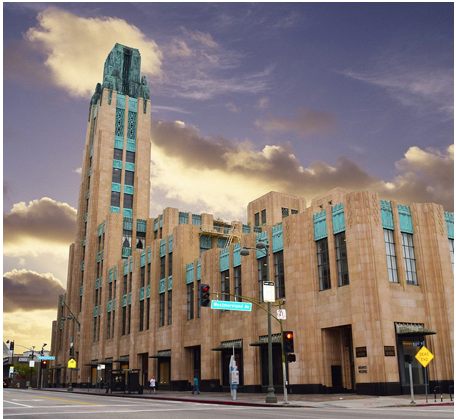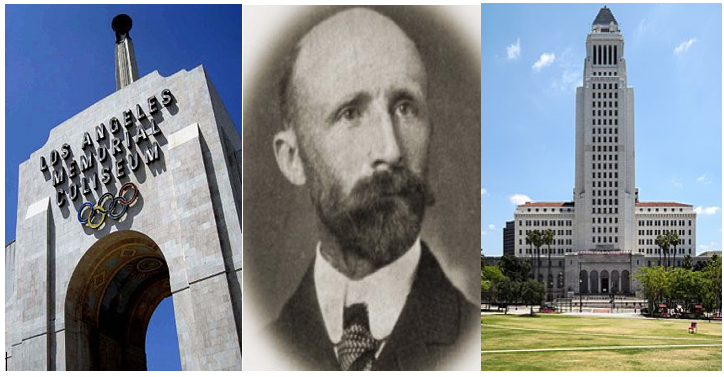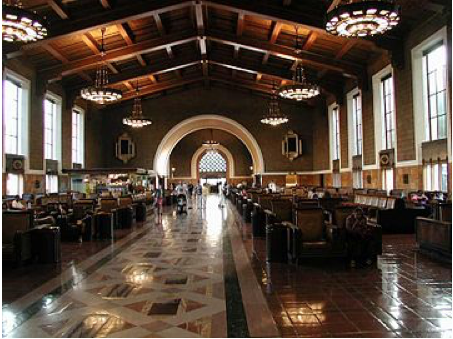CommentsDEEGAN ON LA-No development controversies here, no discussion of “NIMBYs” or “YIMBYs,” just a collection of well-recognized beauties many people know and love yet may not know who their creator was.
Mention the name of architect John Parkinson and you won’t get much reaction. Then mention City Hall, Union Station, the Los Angeles Memorial Coliseum, Bullocks Wilshire, or Grand Central Market and you’ve just rattled off only some of Parkinson’s iconic Los Angeles buildings.
Parkinson, who was not a native Angeleno yet made such an impact on our city, arrived here in 1894 from England by way of Canada and Seattle, hard on the heels of the Great Panic of 1893, a very serious economic depression that practically ruined him and many others. Four years later, by the time of the economic rebound, Parkinson was already situated in his downtown Los Angeles offices, ready to take on work as the recovery stimulated the city’s growth spurt, a boom in several important industries: railways (including the creation of a transcontinental railhead), the discovery of oil, burgeoning film production, our growth as an international trade hub that was made possible by our enviable deepwater port. The city was blessed with an ideal location with lots of open space to expand, and a perfect climate for residents and tourists.
Having passed away in 1935, all of Parkinson’s works were pre-World War II, and what accomplishments they were, continuing to add architectural vibrancy to our city. His styles segued from the Beaux Arts to Streamline and Art Deco to provide a welcome relief from the prevalent visuals of the low slung, horizontal cityscape that featured humble Spanish adobe styles and the more articulated Spanish Monterey Colonial architecture that still defines LA. Parkinson’s son, Donald, carried on the family business, adding more to the cityscape’s design.
Among many other projects, Parkinson also designed the four buildings at the intersection of Spring and Fifth Streets, now known as John Parkinson Square.
Some of his most familiar standouts include:
The Art Deco Los Angeles City Hall (photo, above) completed in 1928.
Union Station (photo above) which opened in 1939.
Memorial Coliseum opened in 1923 in time to host the 1924 Summer Olympics. Parkinson’s Coliseum will be the first stadium to have hosted the Summer Olympicsthree times, in 1932, 1984, and the future Summer Olympics in 2028.

Bullocks Wilshire (photo above) an Art Deco masterpiece that was originally a luxury department store when it opened in 1929, and is now home to Southwestern Law School.
Grand Central Market in continuous operation since 1917.
The city where Parkinson made his mark was far different LA today. In the first quarter of the 20th Century about half the population lived in downtown Los Angeles. Encouragingly, there’s been a shift back to living in DTLA, with occupants living in a mix of brand new skyscrapers and repurposed historic buildings that date back to Parkinson's era. The hillsides and the San Fernando Valley were wide open spaces back then, yet to be discovered for canyon living in the hills and suburban mass tract housing in the valley. The West Side was also sparsely populated.
During Parkinson’s time, nobody was breathing down his neck, challenging his designs, or saying “not here.” It would be decades before the emergence of Historic Preservation Overlay Zones (HPOZ), homeowner associations, and the even more narrowly focused community groups such as Neighborhood Councils. Springing from new iterations of local community groups have been the voices of “NIMBYs” (not in my back yard), and most recently the “YIMBYs” (yes, in my backyard).
Parkinson may not have been able to imagine what his adopted city would have looked like today, or how significant his major buildings would become, achieving iconic status. These structures were so strongly designed that they will continue to command attention, no matter what sort of 21st Century contemporary developments are built nearby.
Parkinson would also be surprised to take in the 360% panoramic views of Los Angeles if he were able to visit the observation deckthat he incorporated at the top of City Hall. Visually, it tells the story of how much the city has developed in the 124 years since he arrived here and got to work.TheCity Hall Observation Deck is free and open to all, so go there and take a ride to the top (it involves switching elevators almost at the top, and finally taking some stairs). You’ll be able to see the city and pick out some of Parkinson’smore famous landmarks. You can even try to imagine how he would feel if he could take in that view today.
Other resources:
KCRW Podcast - Press Play with Madeleine Brand
Iconic Vision John Parkinson, Architect of Los Angeles by Stephen Gee.
(Tim Deegan is a civic activist whose DEEGAN ON LA weekly column about city planning, new urbanism, the environment, and the homeless appear in CityWatch. Tim can be reached at [email protected].) Edited for CityWatch by Linda Abrams.
















